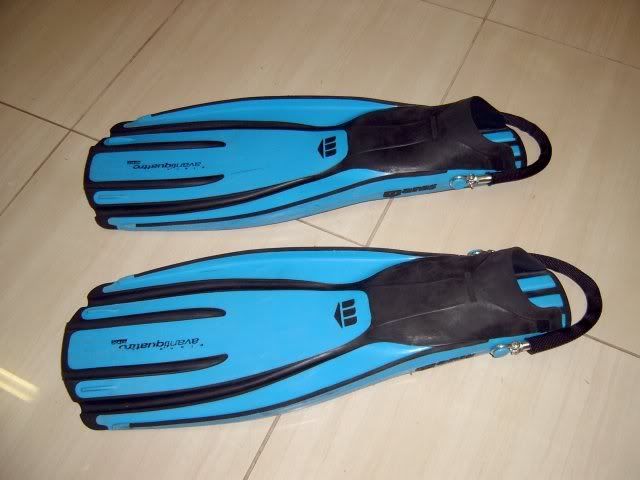Assembled my spring straps last night. I bought a pair of 11" SS springs complete with tube webbing from a friend while on holiday last week (the DIY genes just won't stop!). I purchased the shackles (5mm/~3/16") from a marine supplies store and a roll of cave line from a rigging supply shop in Cape Town. (The roll of cave line was for reels and spools, not just for the spring straps!)
Removed the existing strap assemblies from both fins. I then filed down the plastic lugs below the posts with a set of pin files, so that the posts were as near to round as possible. This was probably the most time-consuming part of the process.
I measured the spring from post to post, and it looked like the 11" spring would be perfect as-is (size 10 shoe (UK)/XL bootie). Cut the cave line long enough to give me 13 to 14" plus ends for the knots. This seemed to be about right for the maximum extension for the spring in "normal" use. Tied a double fisherman's knot in the one end of the line. I then fed the other end of the line through the spring and attached the shackle through the loop and the spring. Tied off the other end with another double fisherman's knot. Cut and sealed the line ends with lighter. I then attached the second shackle through the cave line loop and the spring. Then I pulled the loops on each of the cave line taut and stretched the spring a few times to get the excess length of the cave line "seated" inside the spring.
I then repeated the above process with the other spring.
I attached the shackles onto the posts, which were then quite loose. They sprang (sprung?) off a few times, so I had to take care that I did not end up losing an eye(!). I used a vice to bend the shackles tighter onto the posts. It was quite tricky holding the fin to guide the shackle into the right position. I made small adjustments each time, so that I did not end up over-tightening the shackles. In the end, it feels like I have about 1mm clearance between the ID of the shackle and the OD of the post.
I tried out the first fin - it fitted perfectly! Very comfortable, easy to don and doff - and rock solid!
I repeated the vice procedure with the second fin and I was done.
As you can see, I have the same problem as the OP with the protruding screws on the shackles, so I will be purchasing some stainless screws to replace these posts when I get a chance. I
really tightened the screws using a shifting spanner, so they should not be going anywhere in the meantime. I also noticed on the web yesterday that 4mm shackles are available. They may fit even better than the 5mm shackles I purchased. They will have to be opened up a bit to clear the "mushroom" on the post and recrimped on the post, but they should work. They should also not have the problem of the protruding screw. If anyone tries them out, post your results.
Side view (note the protruding screws)
My only regret now is that I didn't buy a few extra sets of springs while I was in Cape Town. I am pretty sure that other guys will be wanting a pair too, once they see mine. Although the OEM straps do their job, they really are fiddly. It doesn't get simpler than this.
This was really an enjoyable, easy DIY project. I recommend it if you want to get started in DIYing your own gear. Very satisfying.
Cheers,
Andrew






